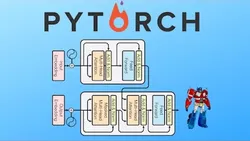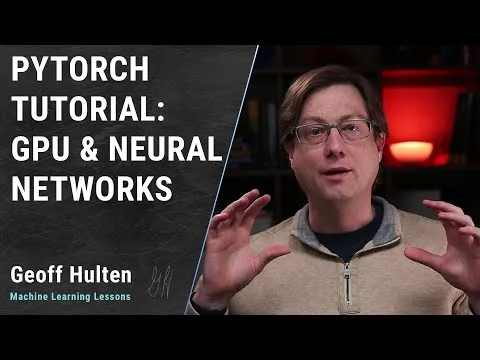
Pytorch Transformers from Scratch (Attention is all you need) 
This course provides an overview of the Transformer model, a powerful deep learning architecture based on the Attention is All You Need paper. It covers the Attention Mechanism, TransformerBlock, Encoder, DecoderBlock, and Decoder, and how they work together to form the Transformer. It also includes a small example and tips on fixing errors. ▼
ADVERTISEMENT
Course Feature
![]() Cost:
Cost:
Free
![]() Provider:
Provider:
Youtube
![]() Certificate:
Certificate:
Paid Certification
![]() Language:
Language:
English
![]() Start Date:
Start Date:
On-Demand
Course Overview
❗The content presented here is sourced directly from Youtube platform. For comprehensive course details, including enrollment information, simply click on the 'Go to class' link on our website.
Updated in [February 21st, 2023]
This course provides an overview of the Pytorch Transformer from scratch, based on the Attention is all you need paper. It begins with an introduction to the paper and a review of the paper. It then moves on to the Attention Mechanism, TransformerBlock, Encoder, DecoderBlock, Decoder, and how to put it all together to form the Transformer. A small example is provided to demonstrate the concepts, as well as how to fix errors. The course ends with a summary of the topics covered.
[Applications]
After taking this course, students should be able to apply the concepts learned to create their own Pytorch Transformer from scratch. They should be able to understand the Attention Mechanism, TransformerBlock, Encoder, DecoderBlock, and Decoder. Additionally, they should be able to debug and fix errors that may arise when creating their own Transformer.
[Career Paths]
1. Machine Learning Engineer: Machine Learning Engineers are responsible for developing and deploying machine learning models. They use tools such as PyTorch, TensorFlow, and Scikit-Learn to build and train models. They also use data engineering techniques to prepare data for model training. With the increasing demand for AI-driven solutions, the demand for Machine Learning Engineers is expected to grow significantly in the coming years.
2. Data Scientist: Data Scientists use data to uncover insights and trends. They use tools such as Python, R, and SQL to analyze data and build predictive models. They also use machine learning techniques such as deep learning and natural language processing to uncover patterns in data. With the increasing demand for data-driven solutions, the demand for Data Scientists is expected to grow significantly in the coming years.
3. Artificial Intelligence Engineer: Artificial Intelligence Engineers are responsible for developing and deploying AI-driven solutions. They use tools such as PyTorch, TensorFlow, and Scikit-Learn to build and train models. They also use data engineering techniques to prepare data for model training. With the increasing demand for AI-driven solutions, the demand for Artificial Intelligence Engineers is expected to grow significantly in the coming years.
4. Natural Language Processing Engineer: Natural Language Processing Engineers are responsible for developing and deploying natural language processing models. They use tools such as PyTorch, TensorFlow, and Scikit-Learn to build and train models. They also use data engineering techniques to prepare data for model training. With the increasing demand for AI-driven solutions, the demand for Natural Language Processing Engineers is expected to grow significantly in the coming years.
[Education Paths]
1. Bachelor of Science in Computer Science: This degree path provides students with a comprehensive understanding of computer science fundamentals, such as programming, algorithms, data structures, and software engineering. It also covers topics such as artificial intelligence, machine learning, and robotics. This degree path is ideal for those interested in developing and applying cutting-edge technologies.
2. Master of Science in Artificial Intelligence: This degree path focuses on the development of artificial intelligence systems and their applications. It covers topics such as natural language processing, computer vision, robotics, and machine learning. This degree path is ideal for those interested in developing and applying advanced AI technologies.
3. Doctor of Philosophy in Machine Learning: This degree path focuses on the development of machine learning algorithms and their applications. It covers topics such as supervised and unsupervised learning, deep learning, reinforcement learning, and probabilistic models. This degree path is ideal for those interested in developing and applying advanced machine learning technologies.
4. Master of Science in Data Science: This degree path focuses on the development of data science techniques and their applications. It covers topics such as data mining, data visualization, predictive analytics, and big data. This degree path is ideal for those interested in developing and applying advanced data science technologies.
Course Provider

Provider Youtube's Stats at AZClass
Discussion and Reviews
0.0 (Based on 0 reviews)
Explore Similar Online Courses

Guided Project: Get Started with Red Hat OpenShift

Excel VBA Expert Tutorial

Python for Informatics: Exploring Information

Social Network Analysis

Introduction to Systematic Review and Meta-Analysis

The Analytics Edge

DCO042 - Python For Informatics

Causal Diagrams: Draw Your Assumptions Before Your Conclusions

Whole genome sequencing of bacterial genomes - tools and applications

PyTorch Tutorial - Neural Networks & GPU

Applied Deep Learning with PyTorch - Full Course


Start your review of Pytorch Transformers from Scratch (Attention is all you need)